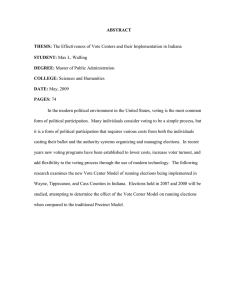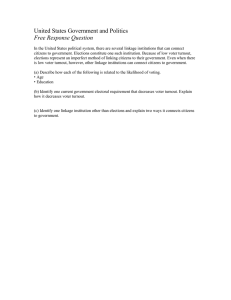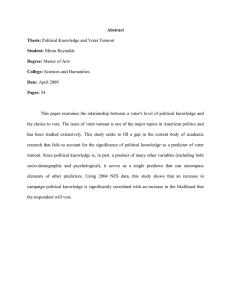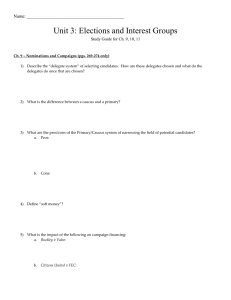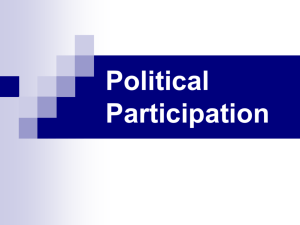Political Participation & Parties ... Test Review
advertisement
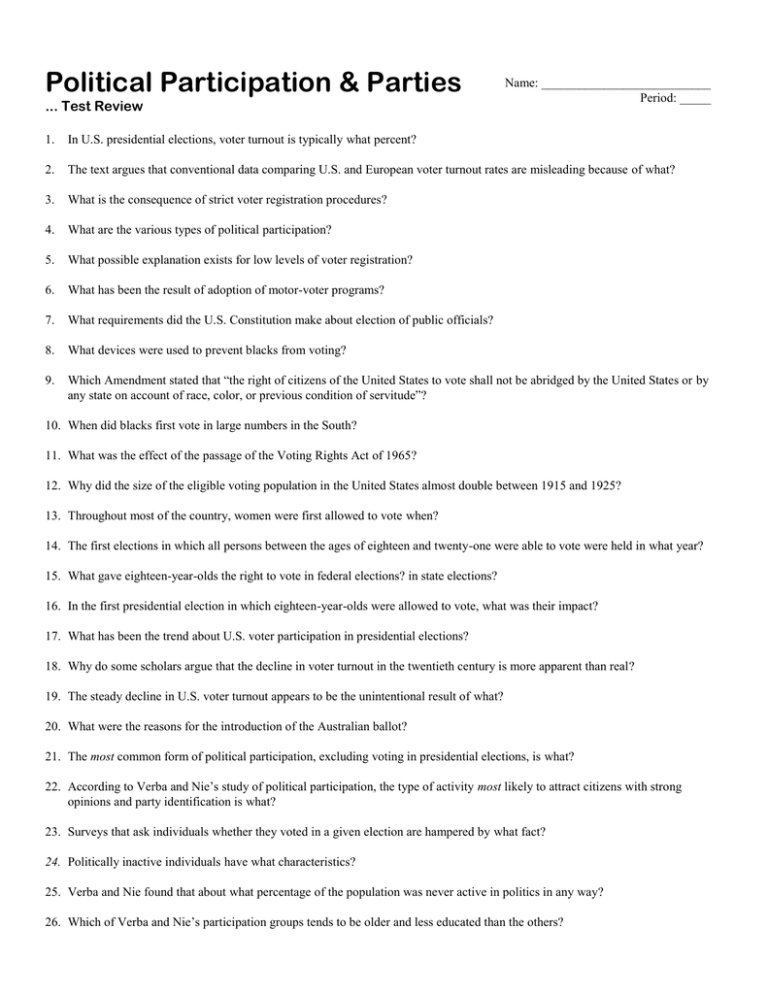
Political Participation & Parties ... Test Review Name: ___________________________ Period: _____ 1. In U.S. presidential elections, voter turnout is typically what percent? 2. The text argues that conventional data comparing U.S. and European voter turnout rates are misleading because of what? 3. What is the consequence of strict voter registration procedures? 4. What are the various types of political participation? 5. What possible explanation exists for low levels of voter registration? 6. What has been the result of adoption of motor-voter programs? 7. What requirements did the U.S. Constitution make about election of public officials? 8. What devices were used to prevent blacks from voting? 9. Which Amendment stated that “the right of citizens of the United States to vote shall not be abridged by the United States or by any state on account of race, color, or previous condition of servitude”? 10. When did blacks first vote in large numbers in the South? 11. What was the effect of the passage of the Voting Rights Act of 1965? 12. Why did the size of the eligible voting population in the United States almost double between 1915 and 1925? 13. Throughout most of the country, women were first allowed to vote when? 14. The first elections in which all persons between the ages of eighteen and twenty-one were able to vote were held in what year? 15. What gave eighteen-year-olds the right to vote in federal elections? in state elections? 16. In the first presidential election in which eighteen-year-olds were allowed to vote, what was their impact? 17. What has been the trend about U.S. voter participation in presidential elections? 18. Why do some scholars argue that the decline in voter turnout in the twentieth century is more apparent than real? 19. The steady decline in U.S. voter turnout appears to be the unintentional result of what? 20. What were the reasons for the introduction of the Australian ballot? 21. The most common form of political participation, excluding voting in presidential elections, is what? 22. According to Verba and Nie’s study of political participation, the type of activity most likely to attract citizens with strong opinions and party identification is what? 23. Surveys that ask individuals whether they voted in a given election are hampered by what fact? 24. Politically inactive individuals have what characteristics? 25. Verba and Nie found that about what percentage of the population was never active in politics in any way? 26. Which of Verba and Nie’s participation groups tends to be older and less educated than the others? 27. Youth, low income, and minority status are associated with which of the participation groups? 28. The willingness to engage in partisan competition separates which two of the participation groups described by Verba and Nie? 29. Which of the participation groups avoids both elections and community groups in its political activity? 30. What factors are the best predictors of a high rate of political participation? 31. Why does religious involvement increase political participation? 32. How does political participation by blacks compare with whites? 33. Compared to the role they used to play, political parties today tend to be what? 34. If measures were taken to improve voter turnout, it is safest to say that they would benefit whom? 35. When Jesse Jackson ran for president in 1984, what happened to black voter registration in the South? 36. How does the voting experience of voters in the U.S. compare to European voters? 37. The text states, “Americans may not vote at high rates, but voting affects a far greater part of the political system here than abroad.” Why is this the case? 38. The term label is most closely associated with the definition of what? 39. Party identification among voters is one way of gauging the strength of a party. Another cited by the text is what? 40. What is the effect of federalism on U.S. political parties compared to European parties? 41. Why are political parties in the United States today are weaker than in Europe? 42. In most states, candidates for office are chosen how? 43. Why should George Washington, among other Founders of our nation, have been so opposed to political parties? 44. How did the Founders see political parties? 45. At the turn of the nineteenth century, Thomas Jefferson organized what political party? 46. The congressional caucus system of selecting a presidential candidate was replaced by what? 47. In recent years the Republican National Committee has outdone the Democratic National Committee in what ways? 48. How often does the national convention meet to nominate a presidential candidate? 49. Between the national conventions party affairs are managed by what? 50. Which political parties became more bureaucratized and which more factionalized in the 60s and 70s? 51. What is true about the formula by which delegates to the nominating conventions are apportioned? 52. Recent ideological trends in the major parties indicate what? 53. The term superdelegate refers to what? 54. Within both major parties, it is what level that has most obviously declined? 55. The late nineteenth and early twentieth centuries are often considered the heyday of what? 56. What are often factionalized and value principle above all else? 57. What are the reasons that people can join a party for reasons other than patronage? 58. The Kennedys, Humphreys, Wallaces, and Byrds are all examples of politicians who built their campaigns around the support of what? 59. To win in a plurality system such as that in the United States, a candidate must get how many votes? 60. The plurality electoral system in the United States means what for U.S. political parties? 61. Why should elections based on a plurality system discourage new parties from forming? 62. The most dramatic example of the winner-take-all principle in the U.S. electoral system is what? 63. The most recent independent candidate for president who was able to get on the ballot in every state was who? 64. How do the election laws of many states affect minor parties? 65. Which of kinds of minor parties tends to endure the longest? 66. Many strong social movements in the United States (e.g., the antiwar movement of the late 1960s) never produced a significant third party. Why? 67. What are major sources of conflict within the national parties? 68. In terms of ideology, national convention delegates, compared to their respective party members, tend to be what? 69. What is a caucus? 70. How do those who vote in primary elections compare to all citizens in general? 71. What is the disadvantage of the new primary system that has developed in the United States? 72. How can the differences between the two major parties in the United States best be characterized?
